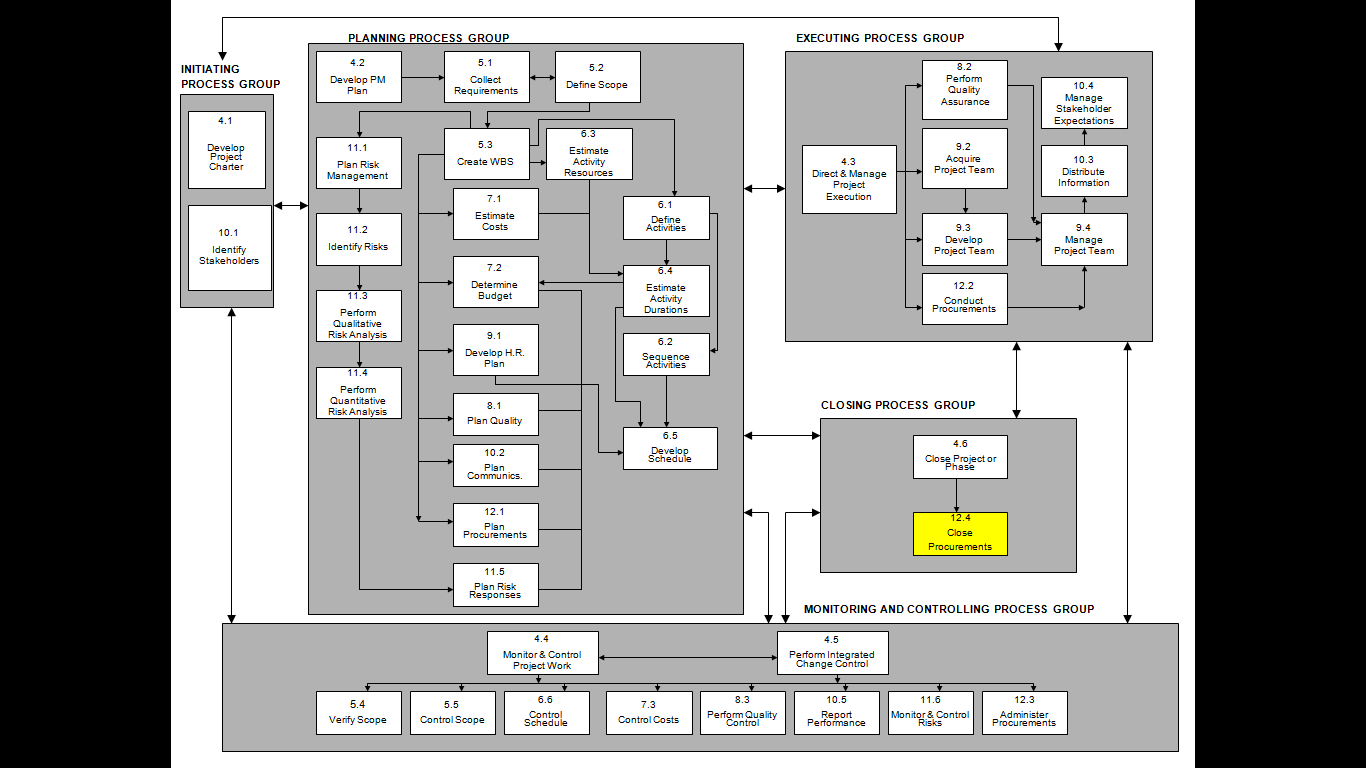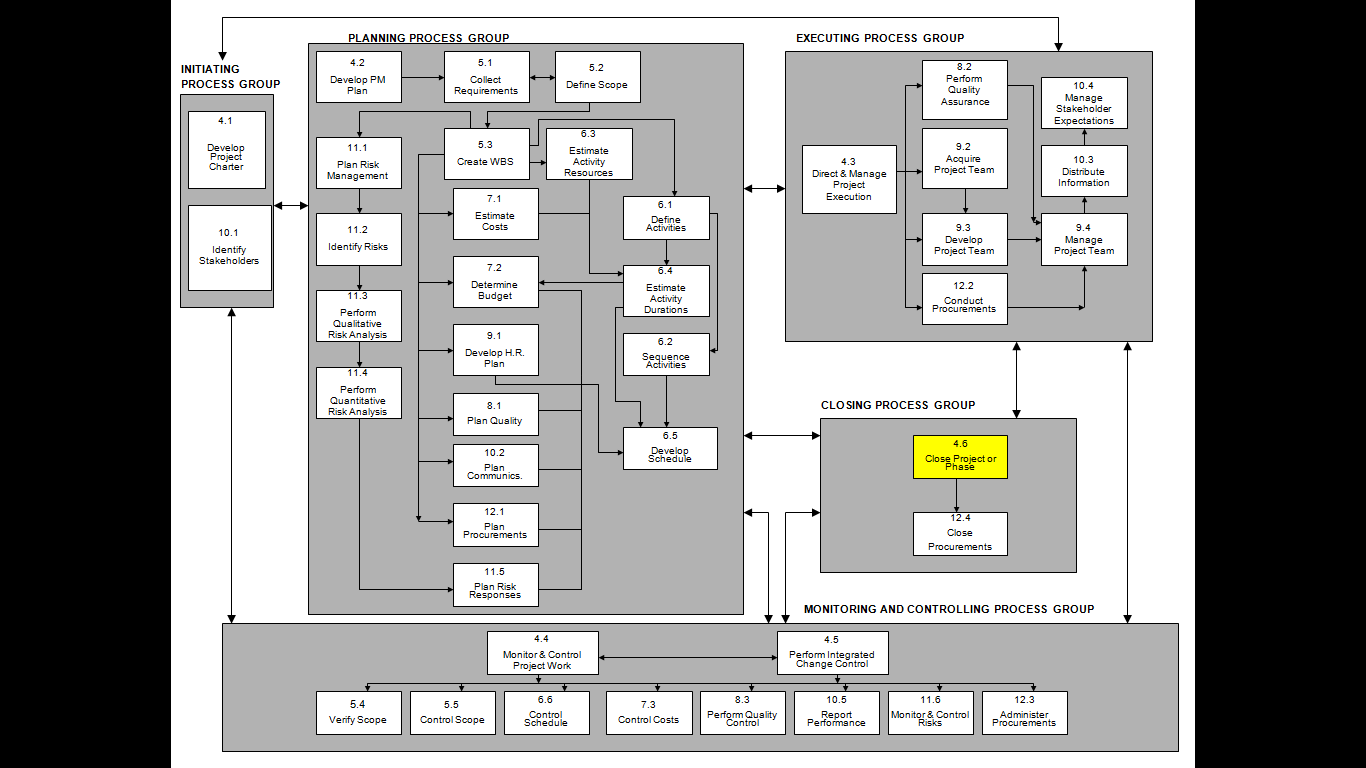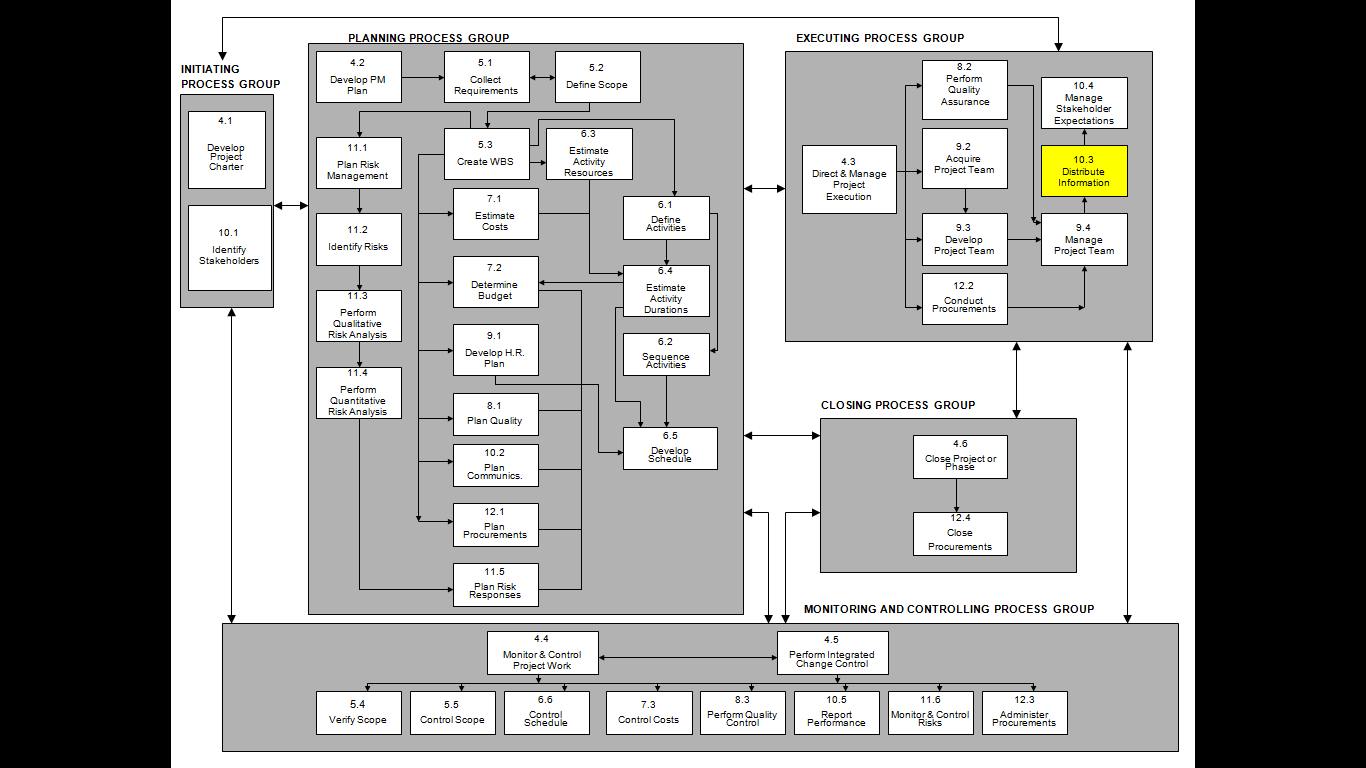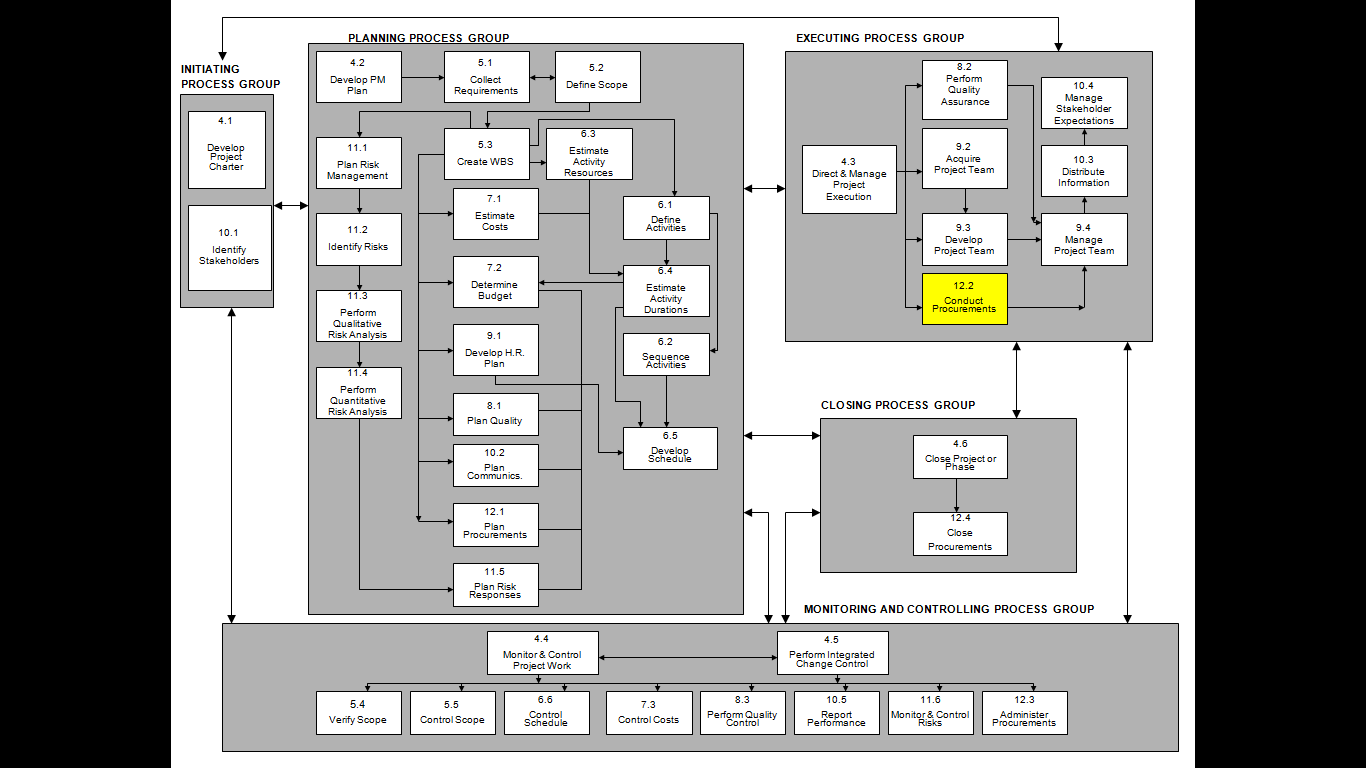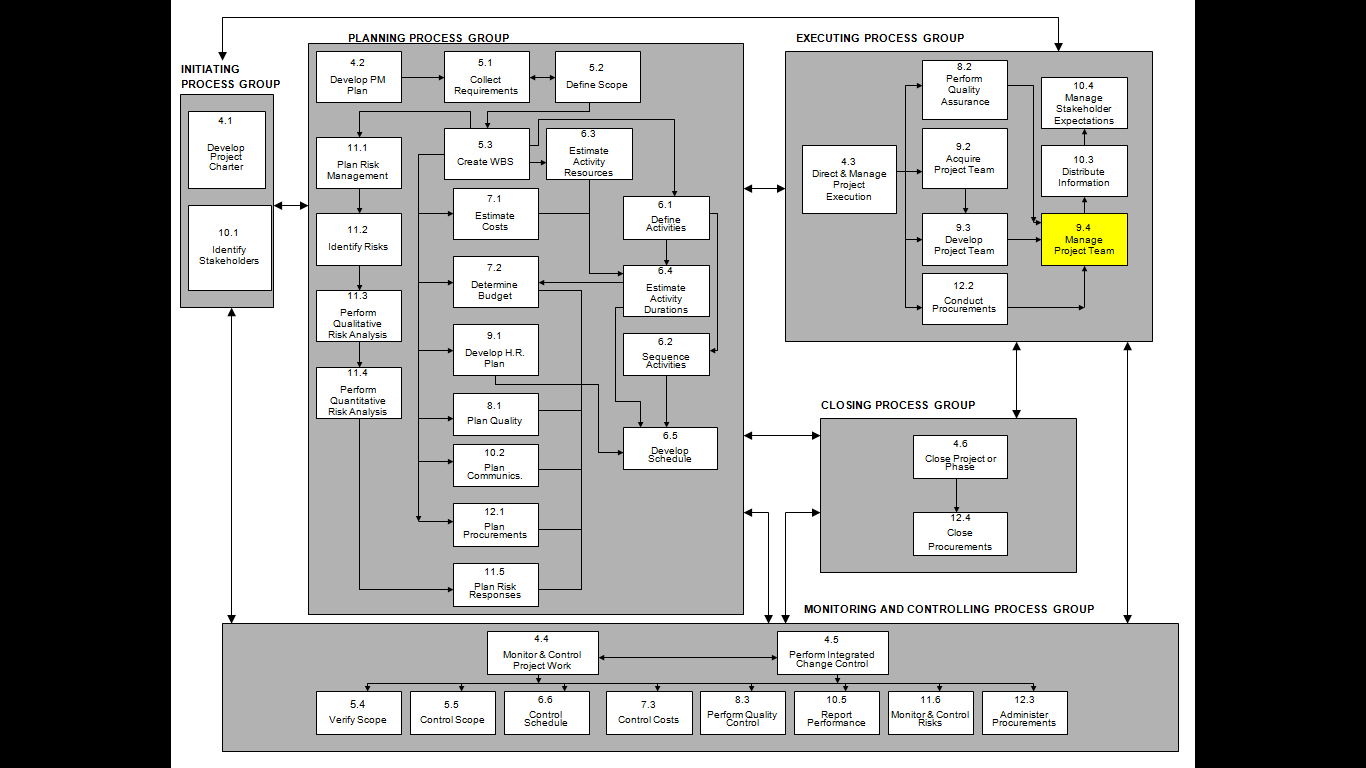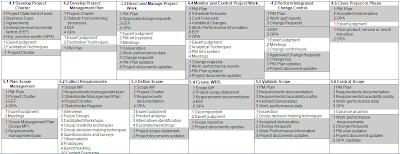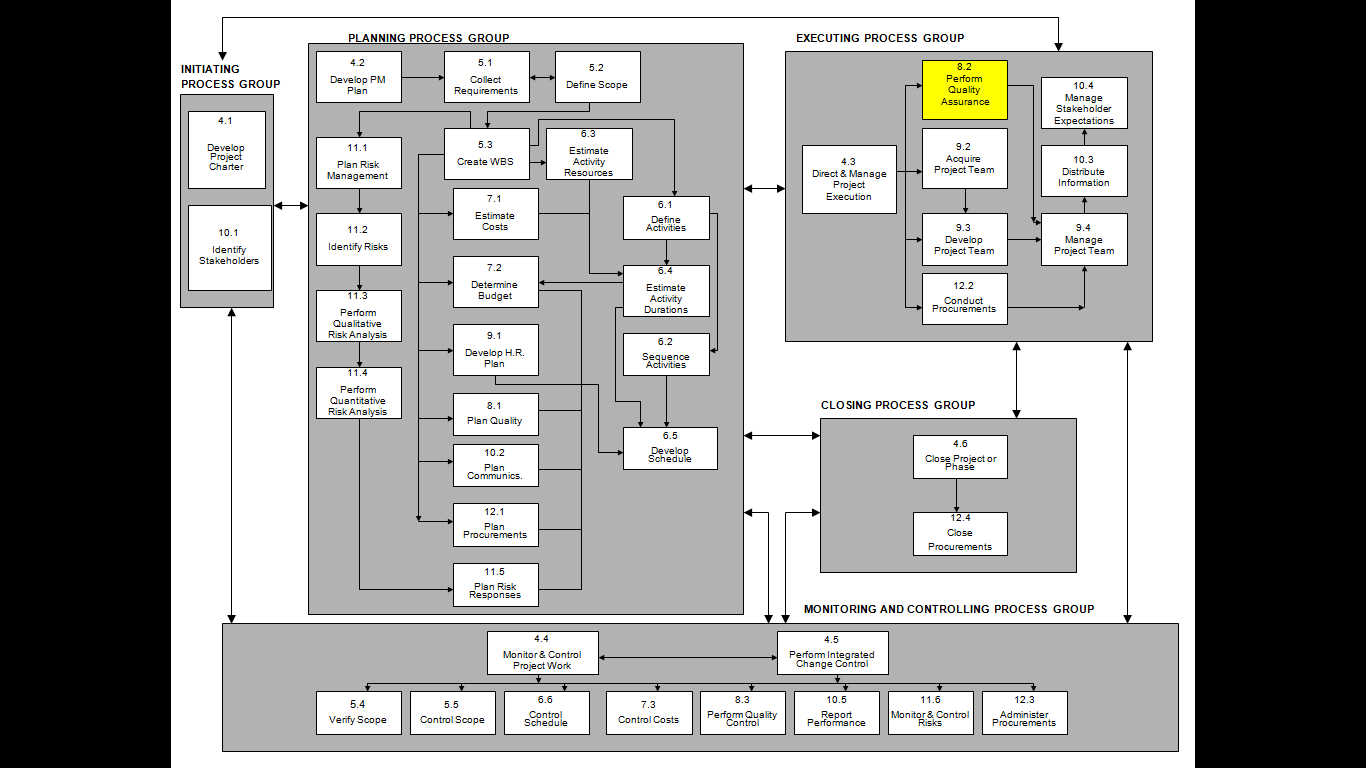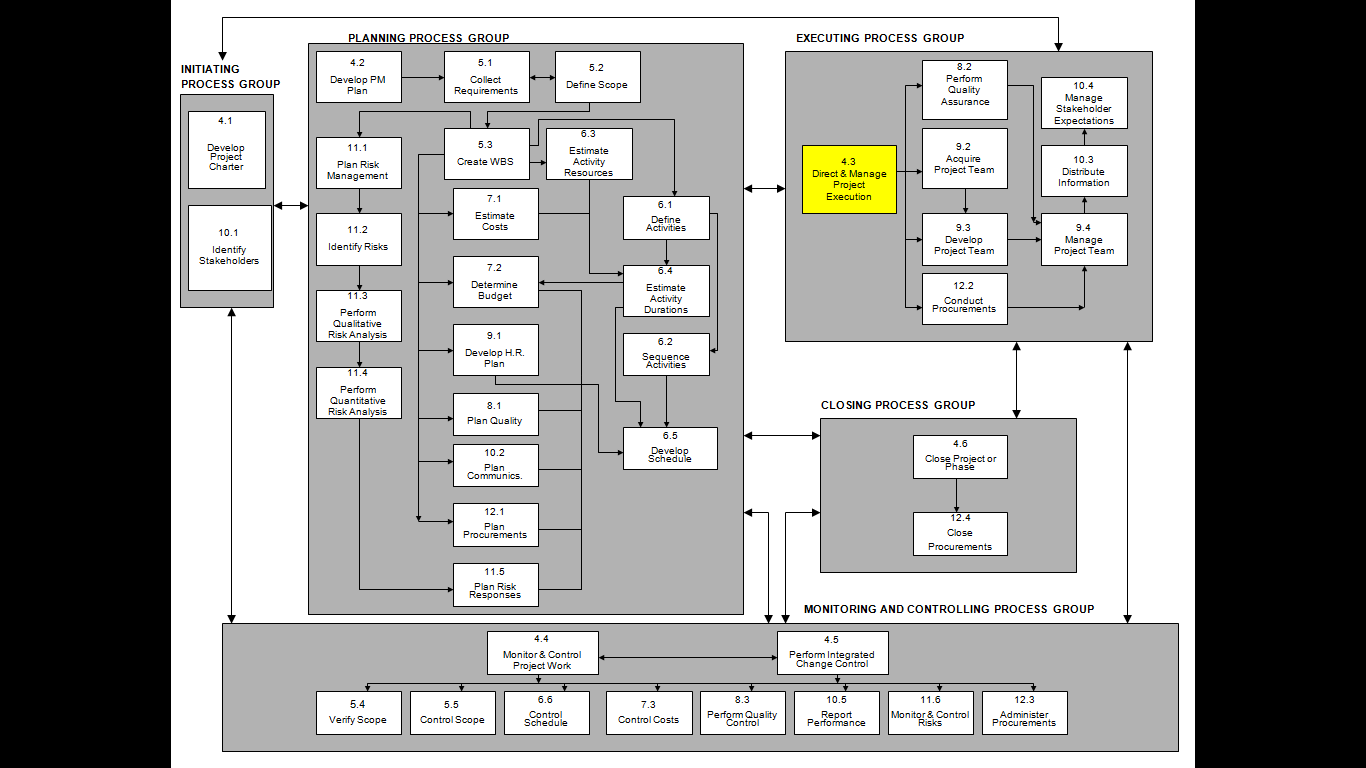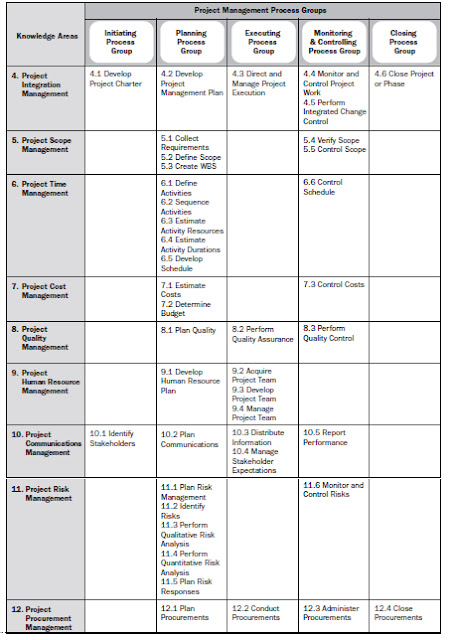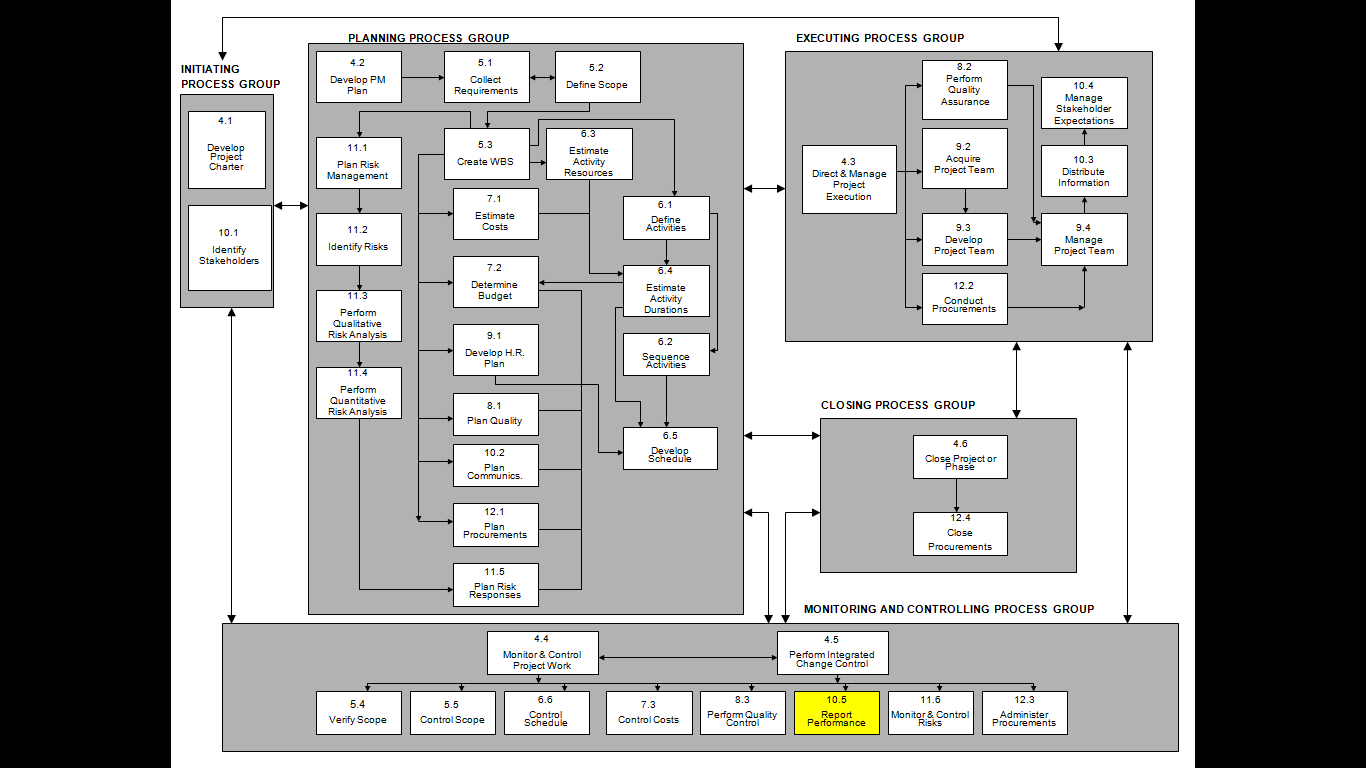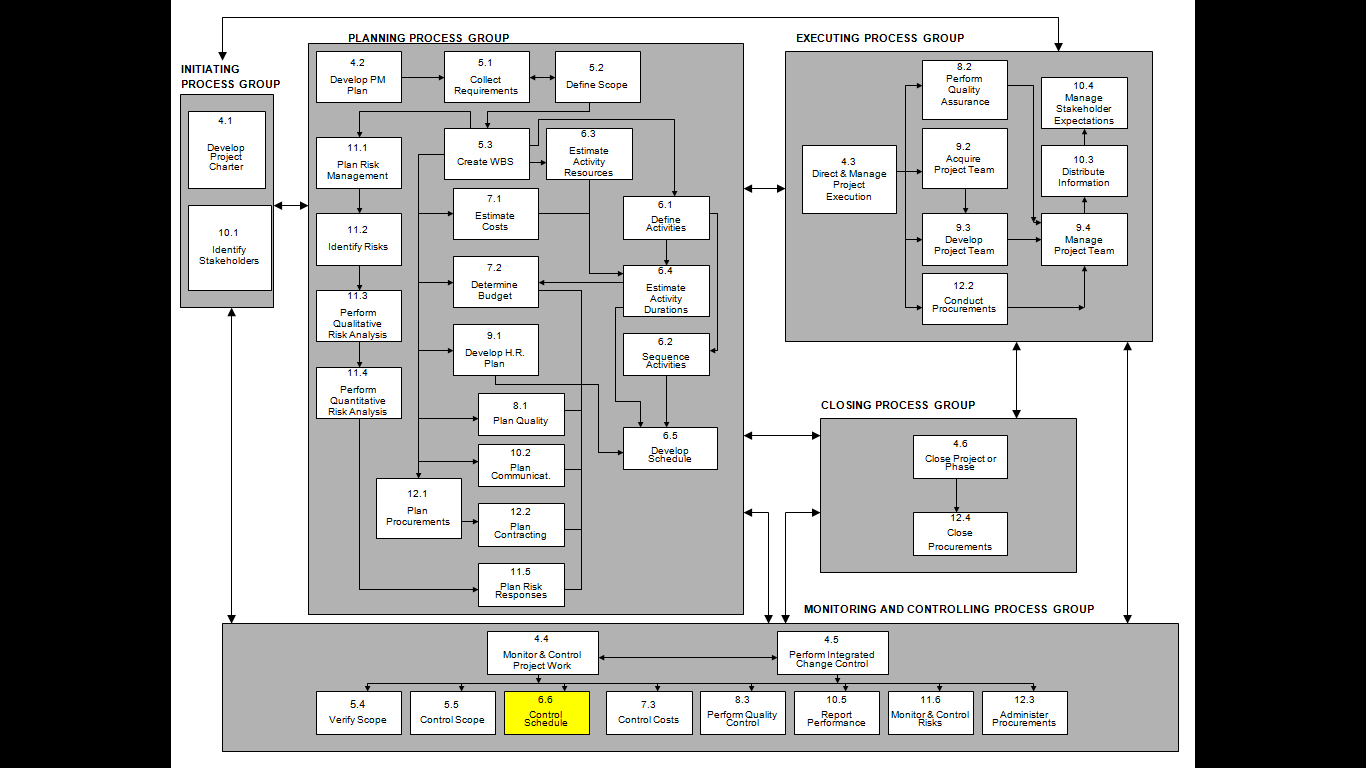With excerpts from my Project Management Novel, I will illustrate the many processes of the PMBOK. Here is the twenty-seventh one: Control Costs. Use this map to see how this process fits into the scheme of processes.

“All right. You’ve convinced me we’re going to Eireland next. But now we need to focus on this tower. What can we do to make this tower better than the ones before?”
“We have to control costs. Remember, we’ve taken all th’money and won’t get any extra from Sir Kay. Any savin’s we get go directly into our pockets and any overcharges come out of them.”
“Right,” agreed Gwilym. “And how do we do that?”
“I was thinking about that, Gwilym and I think I have an answer. But I have to talk it out. Will tha listen for a while and tell me if I’m crazy?”
“If it has anything to do with numbers, I can tell you with certainty, you’re not crazy.”
“Thanks, Gwilym.” Fred thought for while, then said, “Tha know how we break down th’project into deliverables, then each deliverable into tasks? Then we figure out how many hours a man needs to work on each task and how much we pay them per hour to figure out how much each task costs. We add th’materials to that and we have the cost of every task, every deliverable and finally th’whole project.”
Gwilym nodded his head.
“But then th’project gets going and some tasks cost more and some less and we end up under or, more often, over th’budget we set.” He looked again to Gwilym for confirmation. Gwilym nodded.
“Right then. So when Caratacus was asking us how we were doing with our budget we could show him from our project plan what we were supposed to have spent and from our purses how much we had spent and we were usually a little over budget. But then we ended up finishin’ under budget. Let me show tha what th’problem is.”
Fred flipped over the map and drew the two axes of a graph on it. He labeled the vertical axis ‘Ag’ and the horizontal ‘Days’. Then he drew a curve on it looking like a flattened out letter S that started at the intersection of the two axes and curved its way to the upper right.

“This is th’way we usually plan to spend money on our projects. A little at first while we plan it, then a lot in th’middle while we do all th’heavy work, then a little at th’end to finish up the loose ends.” He labeled this line ‘Planned Costs.’
He then drew some dots below this line saying all the while, “And these dots represent our weekly expenses in wages and materials for the first half of th’project.” He connected the dots in a rough curve revealing a curve that was lower than the first one. The curve ended about halfway along the first curve. He labeled this one ‘Actual Costs.’

“So, Gwilym, how is this project doin’?”
“It’s doing well, Fred! We’re under budget.”
Fred shook his head. “Nay Gwilym. That’s what I’m tryin’ to show tha. Tha can’t know from these two lines how thy project is really doing.”
“Why not?”
“What if I were to look up from these graphs at th’tower and tell tha, ‘Th’tower is completely finished.’ Then what would tha say about th’project?”
“I’d say, we were way under budget. We did really well.”
“Aye, fair enough. Now what if I looked at th’jobsite and told tha, ‘Th’tower is barely started, we’ve only dug th’foundations.’ Then what would tha say?”
Gwilym said nothing. He looked at the graph and slowly nodded his head, his chin resting in his hand. “You’re right Fred, the graph you made only shows money spent per week against money planned to be spent for progress. It doesn’t show actual progress.”
Fred beamed and he fumbled around for a third color of ink. “But here’s th’thing, Gwilym. There’s another line we can draw on this graph that shows progress.” He drew another line in between the two and labeled this ‘Earned Value.’ “This line shows thy progress, Gwilym. I’ll show tha in a minute how tha gets this line. But right now, let me explain what it means. This line shows th’amount of work tha’ve earned by doing some tasks. When th’project is over,” Fred completed the line to finish at the same height as the Planned Costs line, though at a later date, “Th’cost of this line will equal th’Planned Costs line. That’s because th’value you get from th’completed project can never be more or less than th’planned cost of th’tower.”
He then extended the Actual Cost line, ending it at the same time as the Earned Value line but at a lower point on the cost axis. “We hope costs will finish less than planned, meanin’ profit for th’project. And these lines finish at th’same time. We stop spendin’ money when th’project is over.”

“I like it so far, Fred, but how do you get this line?”
“Well that’s where I hope I’m right and I don’t have one of those…circular arguments tha told me about. Hear me out and tell me if I’m crazy.”
Gwilym nodded and sat back down to listen.
“We already know what every task is supposed to cost and when we’re supposed to do it, giving us th’first line. Then th’project starts and we start doin’ work while spendin’ money. One of our first tasks is diggin’ th’foundations. We planned on ten men diggin’ all day for two days. That was goin’ to cost th’budget twenty silver. But one man got sick th’second day and didn’t show up but th’rest of th’men worked harder and finished on time anyway. How much did that task cost th’project’s budget?”
“Nineteen silver.”
“Aye. But how much value did th’men perform for th’project?”
Gwilym thought in silence for a while. Then he pointed to the planned costs curve and said, “They did a portion of this line, they did twenty silver worth of this line.”
“Twenty silver, right?” asked Fred. “They get th’planned value of th’task as credit on this third line. And if th’foundation stones cost more than we had planned and th’next task costs us 50 silver instead of 45 silver, how much value does that task earn?”
Gwilym was standing now and nodding. “Still 45 silver. Yes, Fred, I think you have something here. This ‘Earned Value’ curve shows how much progress you are making on the project on a daily basis using the ‘Planned Costs’. And if you are halfway through a task at the end of the day, the project gets credit for half the planned costs of that task. You can add these up every day and at the end it will add up to the entire budget of the whole project. It’s brilliant, Fred!”
“It gets stranger, Gwilym, when tha looks at how to use it. When I compare th’actual costs with th’earned value I can see how much money I’ve spent compared to how much I’ve accomplished and show how much under or over budget we are.”

Gwilym’s eyes grew wide and he clapped Fred on the shoulder. “It’s brilliant!”
“Aye,” but Fred’s shoulders drooped further and he looked like a kicked dog. “But this is where it all falls apart. When I compare th’planned costs with th’earned value I can see how far ahead or behind schedule I am.”
“What’s wrong with that?”
“Look at th’units, man! This says I’m 40 silver pieces behind schedule! What th’hell does that mean, ‘40 silver behind schedule’? How am I supposed to explain that to anyone?”

Gwilym studied the graph. “You are behind schedule. You’ve completed less actual work than planned. So the direction is right. I suppose you could convert the silver into percent of the project and that back into schedule to say you’re 5% behind schedule and that means 2 weeks behind schedule on a year-long project. But I suspect that using gold and silver is the right way to do it.”
“Why, Gwilym?”
“Sometimes when I have to tell my sponsor how my project is doing, I have guessed about how I’m doing on budget but I could tell from the schedule how I’m doing on time. I could tell him that I was two weeks behind schedule but fifteen gold under budget. I’ve seen his face and he’s confused. ‘Is that good or bad?’ he’s thinking because he can’t compare gold pieces with weeks. Now you’ve given us a way to compare apples to apples. We’re 20 silver pieces under budget but 40 silver behind schedule. So, in general, we’re 20 silver in the hole.”
Fred’s eyes grew blank and Gwilym recognized this expression in his old friend as when he was internalizing a concept. He remained silent. Finally Fred responded. “Aye, Gwilym. Tha have it! And it works every way. As long as tha calls bein’ under budget a negative number and behind schedule a negative number, tha can add th’numbers together and get th’overall status of th’project. If tha be under budget and ahead of schedule, tha adds two positive numbers. If tha be over budget and behind schedule, tha adds two negative numbers. And if tha be behind schedule and under budget or ahead of schedule and over budget, tha adds a negative to a positive and sees if tha is positive or negative in th’whole. It works!”
“And how do you make sure that bad things are always negative numbers?” asked Gwilym.
“Easy!” replied Fred. “Always subtract th’other number from th’earned value number. Cost Variance equals Earned Value minus Actual Cost. Schedule Variance equals Earned Value minus Planned Costs.”
Gwilym nodded. Then he had an insight. There’s another way to use this graph to see how far behind schedule you are. Look at this.”
Gwilym drew a line between Earned Value and Planned Costs but this time it was horizontal. “See, you can compare it on the Time axis and get the schedule variance in days, not silver.”

“But that’s th’answer to my problem,” said Fred. “I’ve been doin’ it wrong all this time tryin’ to use silver to look at schedule.”
“No,” said Gwilym. “You were right the first time. It is a big improvement to be able to compare costs and schedule the way you did. And this way isn’t strictly accurate either because it only takes work into account, not critical paths or any dependencies. It just gives a rough estimate of how many man-days of work you are behind. No. The more I think about it, we should use your way to estimate how the project is doing in general, we can use this to show how many man days we are ahead or behind schedule, but then use the schedule to show exactly how we are doing against schedule given the dependencies.”
“Tha thinks it useful then? I’m not crazy?”
“You are definitely not crazy, Fred. My gut tells me this is a huge improvement in the way we can control costs. Let’s use it and see how it works.” Gwilym clapped Fred on the shoulder and the younger man’s eyes teared up from emotions at the compliment from the man he respected most in the world.
